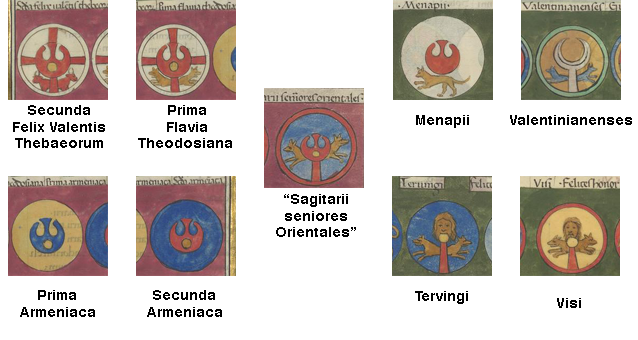
This page created 10 April 2014, and last modified: 30 November 2014 (Maier reference numbers added)

In the eastern half of the empire, the sixth of the 17 units of unit of auxilia palatina listed (12.28 in Ingo Maier's numbering scheme) under the command of the second Master of the Soldiers in the Imperial Presence (i.e. the Magister Militum Praesentalis II) is called the Sagittarii seniores Orientales. The corresponding shield pattern (11#4) as shown in various manuscripts, under the matching label (11.d) Sagittarii seniores Orientales, is as below:

The pattern has a red rim and a blue main filed. The boss is small and yellow, and surrounded by an Amazonian pelta (see below) in red, supported by a red pillar. The forequarters of two running canids, possibly hounds, are shown in brown protruding from the left and red sides of the pelta. This shield pattern, like the others on the top row of the second page illustrating the patterns of the Magister Militum Praesentalis II, appears to be mismatched with its label. For one thing, it is nothing like the other Sagittarii units assigned to the either of the two Masters of the Soldiers in the Imperial Presence, as the following patterns taken from the Paris manuscript should help to illustrate (except the middle one, which is taken from the Froben edition; the reasons for which are to be found here):

These shield patterns, showing a pair of winged Victories flanking what appears to be an image of an imperial couple (or, in the case of the Sagittarii dominici, a single personage), are all very similar, and clearly form a set of related units. Paired Victories flanking an imperial image are a characteristic late Roman motif, and can also be found on, e.g. the Arch of Constantine (although in this case the imperial image has been lost, and single Victories are also used on the same monument). The motif continued into the Byzantine era; the picture below of the early-6th century Barberini ivory in the Louvre shows how the Victories have been transformed into angels, and are now flanking a heavenly Christ rather than the earth-bound emperor.

Photo by Marie-Lan Nguyen and released into the public domain.
So if the shield pattern labelled Sagittarii seniores Orientales does not belong to that unit, then what does it belong to? The shield pattern features two motifs that are not uncommon in Notitia: namely two animals' forequarters, a central device looking like a disc with two deep lobes taken out of it at the 11 o'clock and 1 o'clock positions, and which is only found in the eastern portion of the Notitia; this would appear to be a mythological Amazonian shield.

|

|

|
|
|
|
|
|
|
|
|
As can be seen from the above, Amazons, despite being mythologically located to the north-east, were first conceived by the Greeks as being armed like contemporary Greek warriors; in the 6th century, this meant a heavy Argive shield as depicted above-left. After the Persian invasions, however, Amazons were depicted with light crescent-shaped peltae as carried by the appropriately-located Scythians, although they frequently were shown with a slight "bump" in the middle of the convex section that real peltae did not seem to share, as shown in the middle picture above. This bump seems to have steadily grown, so that by the start of the 3rd century, it could be shown as a central "stalk", as shown above-right. The motifs of Amazonian peltae and animal forequarters are not uncommon in the eastern section of the Notitia (the pelta is not found in the western section at all), as the following patterns taken from the Paris manuscript should help to illustrate:

However, these names reveal no obvious "missing" names, like an unmatched seniores or iuniores unit, for example. The Visi and the Tervingi are a matched pair, both in terms of pattern and name (both names allude to the Gothic peoples); as obviously are the Prima Armeniaca and the Secunda Armeniaca. While not particularly closely related by name, the Secunda Felix Valentis Thebaeorum and the Prima Flavia Theodosiana are also clearly a matched pair in terms of pattern. The Valentinianenses are unmatched in terms of shield pattern, but do form part of a set of names: the Augustenses, the Valentinianenses and the Gratianenses, under the Magister Militum per Thracias. The Menapii have no obvious matching pattern - but they are also not a unit with a seniores/iuniores split (although there is a Menapii seniores in the west), and neither does the name bring to mind any other "twin". Further, one might argue their pattern also appears least like that of the "Sagittarii seniores Orientales", so not only is it is unlikely they are paired together, but even if they were, it would be hard to attach a name to them.
The best candidate might appear to be one of the two other names found on the same line of patterns with the "Mattiaci iuniores" and the "Sagittarii seniores Orientales": the Tubantes and the Constantiniani, based on the notion that the "missing" label is merely misplaced as opposed to completely lost. The Menapii were from Belgium and thus not too far geographically from (but also not so close to) the Tubantes from what is now the Netherlands. They might represent a brigading of "tribal" units. On the other hand, the Constantiniani could well have almost any association. Ultimately, the true identity of the owner of this pattern remains an enigma, but the fact that of the six units carrying an Amazonian shield, four are in the geographically-appropriate Oriental command implies the motif is associated with that command; and thus the "real" unit carrying the pattern ascribed to the Sagittarii seniores Orientales is likely to have been initially assigned to that command.

Return to the Notitia alphabetical unit list page.
Return to my Notitia index page.